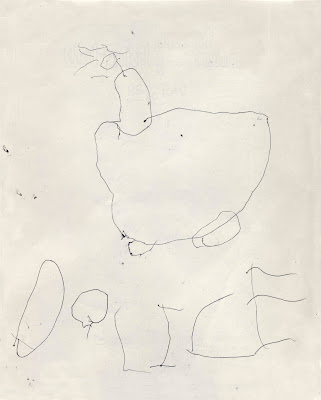ONE LOVELY DRAWING, part 28
I love this drawing of a speeding police car.

Note the frenetic lines for the flashing light; the car's shape distorted by speed, with the ballast in the back and the snout lurching forward; and the way the car hovers above the ground, seeming to kick up gravel behind it. I love the line work (including the occasional ink smear). I love the design and the composition. Applying the same standards I apply to a Picasso, I consider this a terrific drawing.
Sophisticated artists who have mastered technical skills sometimes struggle to unlearn those skills. They hope that, by shedding their knowledge of anatomy and perspective and their hardened patterns of perception, they can draw the world with the same freshness as the child who drew that police car.

Picasso

Dubuffet

Steig
It's not easy to shed established habits of seeing. The process of dismantling skills-- abandoning assumptions, vanquishing muscle memory and starting from scratch-- can be as difficult as acquiring skills to begin with. You can't rid yourself of your assumptions about the world without first going through the educational process of figuring out where your assumptions end and the real world begins.
Today many prominent illustrators have concluded that technical skill will not take them where they want to go. Instead, they deliberately make their pictures ungainly and disproportionate. They use a primitive line, distorting and simplifying in an effort to simulate a fresh, unschooled perspective.

Blitt

Cuneo

Barry

Ciardiello
If an artist deliberately aspires to make pictures that appear awkward, sloppy or uneven, they obviously cannot be judged by traditional standards for technical skill. But what standards should apply? How do we compare a successful drawing by a mature artist with that child's drawing of the police car? Or more importantly, how do we distinguish a successful sloppy, ungainly, disproportionate picture from an unsuccessful one?
One thing is clear: standards for quality still matter-- perhaps more than ever, now that the more objective criteria such as technical facility or physical resemblance are no longer useful.
Some pictures in this genre are truly excellent (for example, I am personally a big fan of William Steig and John Cuneo, and I really like that Picasso picture, Combat de Centaures). But there are other pictures in this category that I think are wildly unsuccessful.

Panter

Schanzer
What makes the good examples so rewarding and the bad examples so unconvincing? For me, design is always a crucial factor. Beyond that, do we measure such pictures by their purity? By their sincerity or authenticity? By the mature concept embodied in the child-like image? At a minimum, the artists who seem most successful at this "newborn" style of art aren't the ones who merely try to mimic children's drawings or who are willfully sloppy, but rather those who recognize and go after the raw, disturbing character of that pre-verbal, non-rational place where (as I've suggested before) innocent children, raving lunatics and savage beasts all dwell.

Note the frenetic lines for the flashing light; the car's shape distorted by speed, with the ballast in the back and the snout lurching forward; and the way the car hovers above the ground, seeming to kick up gravel behind it. I love the line work (including the occasional ink smear). I love the design and the composition. Applying the same standards I apply to a Picasso, I consider this a terrific drawing.
Sophisticated artists who have mastered technical skills sometimes struggle to unlearn those skills. They hope that, by shedding their knowledge of anatomy and perspective and their hardened patterns of perception, they can draw the world with the same freshness as the child who drew that police car.

Picasso

Dubuffet

Steig
It's not easy to shed established habits of seeing. The process of dismantling skills-- abandoning assumptions, vanquishing muscle memory and starting from scratch-- can be as difficult as acquiring skills to begin with. You can't rid yourself of your assumptions about the world without first going through the educational process of figuring out where your assumptions end and the real world begins.
Today many prominent illustrators have concluded that technical skill will not take them where they want to go. Instead, they deliberately make their pictures ungainly and disproportionate. They use a primitive line, distorting and simplifying in an effort to simulate a fresh, unschooled perspective.

Blitt

Cuneo

Barry

Ciardiello
If an artist deliberately aspires to make pictures that appear awkward, sloppy or uneven, they obviously cannot be judged by traditional standards for technical skill. But what standards should apply? How do we compare a successful drawing by a mature artist with that child's drawing of the police car? Or more importantly, how do we distinguish a successful sloppy, ungainly, disproportionate picture from an unsuccessful one?
One thing is clear: standards for quality still matter-- perhaps more than ever, now that the more objective criteria such as technical facility or physical resemblance are no longer useful.
Some pictures in this genre are truly excellent (for example, I am personally a big fan of William Steig and John Cuneo, and I really like that Picasso picture, Combat de Centaures). But there are other pictures in this category that I think are wildly unsuccessful.

Panter

Schanzer
What makes the good examples so rewarding and the bad examples so unconvincing? For me, design is always a crucial factor. Beyond that, do we measure such pictures by their purity? By their sincerity or authenticity? By the mature concept embodied in the child-like image? At a minimum, the artists who seem most successful at this "newborn" style of art aren't the ones who merely try to mimic children's drawings or who are willfully sloppy, but rather those who recognize and go after the raw, disturbing character of that pre-verbal, non-rational place where (as I've suggested before) innocent children, raving lunatics and savage beasts all dwell.


